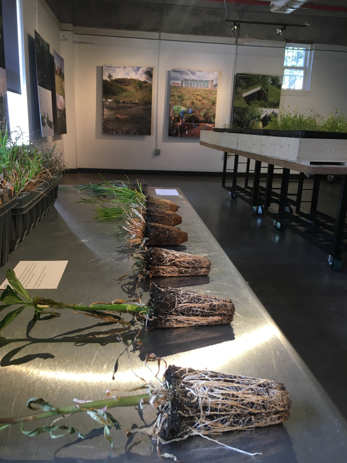In collaboration between the Lady Bird Johnson Wildflower Center and UT scientists, an ongoing exhibition explores different plant propagation, or growing, techniques in landscape construction.
The exhibition, titled “Growing Landscapes: Propagation Materials and Practices,” is located in the Materials Lab of the West Mall Building. It is open until September 1st, 2017.
“This is the first landscape-specific exhibition that I’ve developed and they’ve hosted, and the intent was to demonstrate in a very basic level how landscapes are constructed,” associate architecture professor Jason Sowell said.
The exhibition consists of posters depicting landscaping projects in Texas, such as the Dell Medical School green roof, and live specimens that demonstrate techniques used in those projects in the center of the room.
“Because the techniques that the live specimens demonstrate are utilized in the projects displayed around the perimeter, there was a nice juxtaposition for someone moving through the exhibition and engaging in the material,” Sowell said.
Different propagation techniques include growing plants from seeds, cuttings, live stakes or plugs, as well as grafting and micropropagation, which produces new plants from tissue in a lab.
Sowell said that these different techniques are related to the type of plant species used, and the project’s goals, such as aesthetics, long-term management of the landscape, and ecological function.
John Hart Asher, an environmental designer at the Lady Bird Johnson Wildflower Center, said that the center is currently working on 15 different large scale projects that have many different focuses and goals, including green roofs and restoring grassland and riparian habitats in urban areas.
“(This was) an opportunity to explore and feature processes, practices and, most importantly, biotic resources that are the foundation for creating complex contemporary landscapes,” Asher said. “The increasing desire and need to thread ecosystems through our urban centers requires a fundamental understanding of systems that generate and sustain life.”
Graduate student Matthew Wagoner said that this exhibition is important because landscape technologies are not easily demonstrated, especially in a space like the Materials Lab, which generally focuses on construction materials and practices.
“We work with more ephemeral materials than our architecture counterparts so bringing those materials into a classroom environment is challenging,” Wagoner said.
While some of the plants have become wilted from lack of sunlight, Wagoner said the exhibit is still a way for students to learn about how landscapes are built.
“While I think all of us students would love to personally experience the sites that were highlighted in the exhibition,” Wagoner said, “This format brought little pieces of those projects into the School of Architecture for everyone to learn from.”















